 |  |
By Greg Niemann
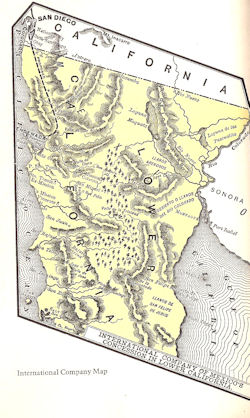
In a clandestine 1890 meeting, the San Diego conspirators reviewed their plot to seize Baja California. Smug in anticipated success to establish their new “Republic of Lower California,” they had already written a draft of the constitution and designed a colorful flag. With resources secured by the Mexican Land and Colonization Company (often referred as the English Company) they felt their chances to wrest the Baja Peninsula away from Mexico were better than earlier attempts.
Following the Mexican-American War (1846-1848) California was split and the present international border was created. As war spoils were divvied up, Mexico ceded California (Alta) and parts of Texas and New Mexico to the U.S., but managed to keep Lower (Baja) California.
The expansionist-minded U.S. however, wanted Lower California. It took a firm counterproposal in the Treaty of Guadalupe Hidalgo negotiations to save what is now Baja for Mexico.
Following the war Mexico was forced to sell the southern parts of Arizona and New Mexico to the U.S. in 1853-54 (Gadsden Purchase).
Lower California, with an 1851 population of only 7,000, was neglected by Mexico yet grew to over 20,000 by 1866, mostly a misfit band of criminals, smugglers and other opportunists.
There were several attempts to "take over" Lower California. A war veteran named Joseph Moorehead landed with troops in La Paz in 1851. He was defeated. So, eventually, was the infamous William Walker who made a storied takeover attempt in 1853 with his huge band of mercenaries.
Then there was Henry Crabb, a former California state senator who led 69 men into Sonora in the 1850s. They were defeated, the vast majority executed, including Crabb, whose head was reportedly preserved in a jar of alcohol and displayed as a warning not to invade Mexican territory.
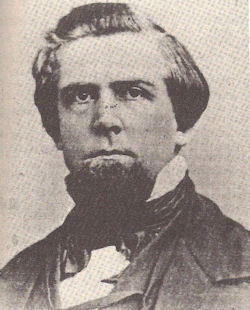
There were official attempts as well. In 1859, U.S. President James Buchanan sent minister McClane to Mexico to negotiate purchasing several Mexican provinces including Lower California. Even after the negotiations were confined to Lower California alone, Mexican President Juarez refused to sell.
In 1881 President John Garfield, through Secretary James G. Blaine, again approached Mexico on her willingness to sell the Peninsula.
Also in 1881, trailblazer John C. Fremont, at the time territorial governor of Arizona, proposed to the U.S. Government that Lower California be cordoned off as a reservation or asylum for the warlike Apache Indians.
Conspirators knew the history
Those San Diego conspirators finalizing takeover plans were fully aware of the long-standing sentiment that the U.S. should get Baja California. After all – they were mostly journalists who had spent much of the previous decade writing inflammatory editorials and articles pushing for a takeover.
The journalists wanted to break away from Northern California influence, grab Baja, and include it in a new state of “Southern California."
Following is an example of the secessionist mindset at the time as reported by Captain John E. Janes in his San Pedro newspaper in 1883: "I hope to see the day when Southern California will become a state and Los Angeles the capital. Lower California we must have; it belongs naturally to Alta California. The Peninsula in the hands of the Mexican government is worthless to them, and always will be... The government of this country must buy it, or we will have to take it for our own protection."
Janes was a convincing character whose rhetoric did incite others to action. In July 1888, Colonel J. E. Mulkey organized a secret society called “The Order of the Golden Field” with the sole purpose of claiming Lower California. The plan was exposed and the “society” was disbanded. Mulkey later joined the 1890 plot.
Yet it was Colonel Janes himself who “let the cat out of the bag” about the Filibuster of 1890 and uncovered the conspirators.
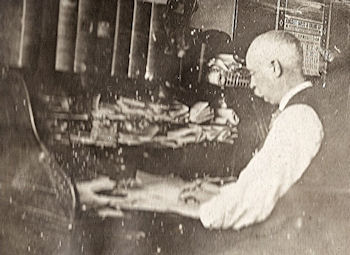
The Filibuster of 1890
The filibuster was a well-planned scheme by a number of Southern Californian newspapermen to capture Lower California, set up an independent government and ultimately annex it to the United States.
Imagine my chagrin to learn that one of the key figures in this shadowy scheme was my great grandfather Bascom A. Stephens – the same newspaperman who penned several books including 1889’s The Gold Fields of Lower California.
In disclosure, the San Diego Union on May 21, 1890 carried a story about the aborted filibuster, naming names, and citing details of the planned takeover. It highlighted my ancestor’s involvement in the initial exposé:
"...about six weeks ago B.A. Stephens arrived in San Diego from Los Angeles and formed an editorial connection with the Informant newspaper. Stephens is well known to Southern California newspapermen as one who has written a good deal in favor of the Annexation of the Peninsula and it is believed that he was as least fully cognizant of the Mulkey scheme. Stephens came to San Diego on the invitation of Augustus Merrill, editor of the Informant, and immediately upon his arrival was informed by Merrill of the details of the plan to take the peninsula.
"Merrill told Stephens that the Mexican Land and Colonization Company had pledged $100,000 to support the scheme and that other money would be raised by individuals who had interests that would be served by the annexation."
The Union report further stated that Merrill introduced Stephens to prominent journalist Walter G. Smith, then editor of the San Diego Sun, who confirmed Merrill’s statements and solicited Stephens’ involvement.
Along with real estate speculator "Colonel" Edward Hill, the principals met the next evening, April 8, 1890, at the posh, two-year new Hotel del Coronado. It was revealed that $25,000 immediate cash from private parties including $5,000 from Hill would be refunded out of the $100,000 the English Company had pledged.
During that and subsequent secret planning meetings held in both San Diego and Ensenada, it was brought out that the English Company, with the exception of its President Sir Edward Jenkinson, was in favor of the scheme because they felt their huge Baja land concession was almost worthless under Mexican rule.

The conspirators were working through the English Company Manager Major Buchanan Scott of Ensenada, and Company Treasurer Mr. McQuilter.
The conspirators’ planning was notably detailed, including how to “take” the Peninsula and organize the new government.
They decided to fill the English Company warehouses with arms, ammunition and provisions and then bring a large number of American "laborers" (read troops) into Mexico. On a certain night a grand fandango was to be given at Ensenada’s Hotel Iturbide overlooking the harbor, to which all Mexican officials would be invited. The conspirators would get them all drunk, bribe the Captain of the Guard, and on a given signal begin the revolution by overpowering the guards.
The English Company offered the use of two steamers used for shuttling colonists and supplies into Baja (the Manuel Dublán and the Carlos Pacheco) for the revolutionists.
Along with the design of a new flag each new department head set about to organize his function.
Walter G. Smith, the Sun editor, was to be the President of the new Republic, with the militaristic title of Governor-General. A former member of the New York legislature, he wrote a Declaration of Independence for Lower California and even read his inaugural address to the group.
The Commanding General was to be Merrill, a former member of the Grand Army and editor of the Informant, who drew up a plan for the military establishment of the new government.
Bascom A. Stephens was to be the Secretary-General. He wrote a draft of the Constitution for the Republic of Lower California, and to date I have been unsuccessful in locating a copy.
Ranford Worthing, who was to be Treasurer-General, read an elaborate finance plan including details of printing money. Col. Edward Hill was to be War-General. C.A. Harris, a Baja landowner, was named Surveyor-General. Three other Cabinet posts (Attorney-General, Postal-General and Industrial General) were unfilled, presumably to be occupied by supportive Mexicans.
Janes was planning an independent foray to take Lower California, but was talked into joining the San Diego newspapermen. However, he harbored a vision that the others were surely to profit monetarily and were cutting him out.
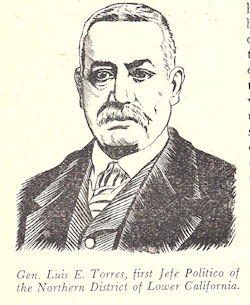
Back in San Pedro, Janes wrote enough hints about the filibuster that both Smith and Merrill went to visit him and request his silence. Their visits were reported in the San Diego Union and leaks about the filibuster were feared.
Their fears were grounded as the San Diego Union got wind of the entire plot and exposed it in the May 21 edition, thus forever making a moot issue as to whether or not the fandango caper would have worked.
The next day the San Francisco Chronicle outlined the entire folly and included biographies of the conspirators. Editorials in both papers called for the U.S. government to do something to those who openly defied the treaty relations between Mexico and the United States.
During the hectic days following the divulgence, there was a lot of finger-pointing, with Janes accusing the other conspirators and vice-versa.
Smith was challenged to a duel by Mexican Colonel Manuel A.C. Ferrer for what he claimed an insult to Mexico. The duel never took place.
The Mexican Land and Colonization Company (The English Company) of course denied any involvement, although Manager Scott was on the next boat to England. Lower California Politico Jefe (Governor) Luis Torres displayed a willingness to work with the new company officers and his belief that the filibustering conspiracy was "limited to a very few, irresponsible adventurers" helped Mexico’s President Porfirio Diaz determine that the case was closed.
While the filibuster caused a lot of general excitement in Mexico City, President Diaz told an Associated Press correspondent that he placed little importance to the movement. He knew the United States Government would not allow the neutrality to be violated and the Mexican Government would protect her territory.
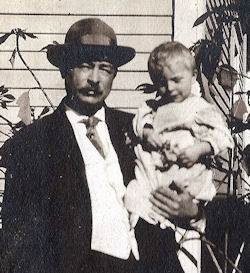
Thanks to the gracious attitudes of Governor Torres and President Diaz none of the conspirators was jailed for his involvement.
U.S. Secretary Blaine apologized to the Mexican government on behalf of the U.S President, and responsible journalists across the country berated their fellow newspapermen for their hare-brained scheme.
Stephens’ daughter Minerva (Niemann) was a carefree 8-year-old when all this was going on and fortunately didn’t have to see her dad carted off to jail, or worse – see his head in a jar. She was such a sweet and mild-mannered Grandma, it’s hard to imagine her dad as an international conspirator.
Even today there are those who want to carve up the state of California. The latest proposal plans to create six separate states. But at least they’re not talking about making Baja one of them.
About Greg
Greg Niemann is the author of Baja Fever, Baja Legends, Palm Springs Legends, Las Vegas Legends, and Big Brown: The Untold Story of UPS. Visit Greg's website.

Changed some money. Good rate and friendly people.

Save the hassle of trying to find a Mexican Insurance shop or waiting in line if you do. Baja Bound...

Day, night, while they are on vacation. Anytime. They are the best most helpful insurance companies...